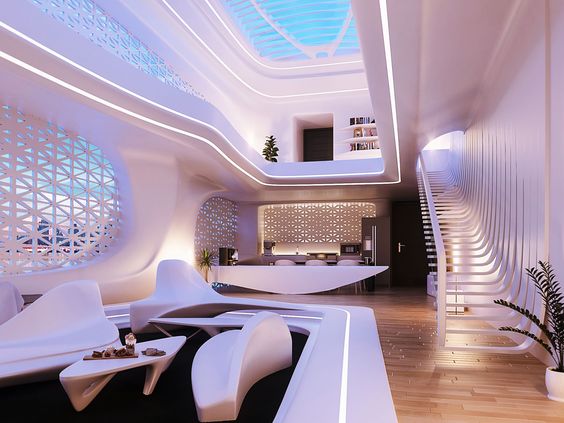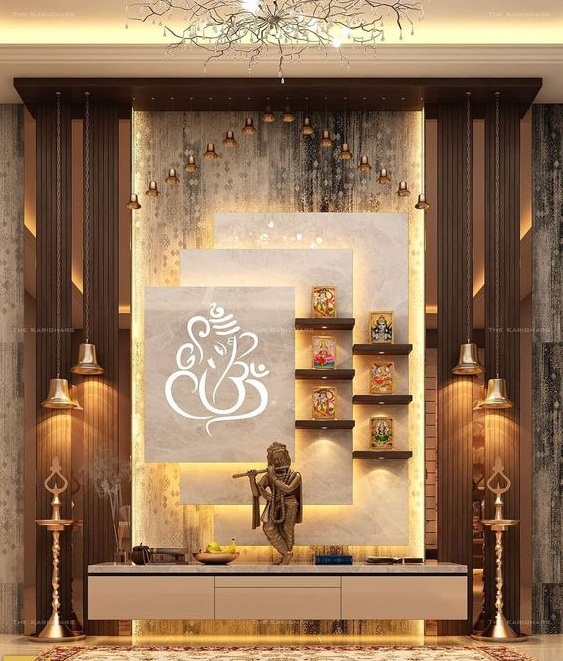Interior Designing in India – A Look at the Future and Emerging Trends.
Interior designing in India is a constantly evolving field that has seen significant growth over the past few years. With rapid urbanization and an increase in disposable income, more and more people are investing in home decor and design. As the industry grows, so do the emerging trends. From incorporating sustainable materials to experimenting with bold colours and patterns, the world of interior designing in India is buzzing with new ideas and fresh perspectives. In this article, we take a closer look at the future of interior designing in India and explore some of the emerging trends that are shaping the industry. Whether you’re an interior design enthusiast or simply looking to spruce up your home, read on to discover what the future holds for interior designing in India.
What is interior designing?
Interior designing is the art of enhancing the interior of a building to make it more aesthetically pleasing and functional. It involves the creative use of space, colour, and materials to create an environment that is both comfortable and appealing. Interior designers work with architects, contractors, and clients to ensure that the design of an interior space meets the needs and preferences of the people who will use it.

They are responsible for choosing the right furniture, fixtures, and accessories, as well as selecting the appropriate colours and materials to create a cohesive and visually appealing space. Interior designing has become an essential part of modern architecture and is widely practiced in India.
With the emergence of new technologies and materials, interior designing in India is rapidly evolving, and new trends are emerging to meet the changing needs and preferences of Indian consumers.
CONTENT
Section 1: Introduction to the Interior Designing Industry in India.
Section 2: The growth of interior designing in India
Section 3: Emerging trends in interior designing in India
Section 4: Sustainable materials in interior designing
Section 5: Eco-Friendly Materials and Sustainable Design
Section 6: Minimalism and Natural Elements
Section 7: Space-Saving Designs and Multi-functional Spaces
Section 8: Technology in Interior Designing
Section 9: Colours That Will Rule Interior Designing Trends in India
1. Introduction to the Interior Designing Industry in India
The interior designing industry in India has come a long way in recent years. With the growth of the economy, the demand for interior designers has also increased. Interior designing is no longer a luxury only for the wealthy; it has become an essential part of every home and office.
The industry has become more accessible to the masses, and this has led to the emergence of new and innovative trends. Nowadays, people are more focused on creating functional and aesthetically pleasing spaces. In India, interior designing is not just about decorating homes, but it is also about creating spaces that reflect the cultural heritage of the country.
The industry has witnessed a lot of changes in recent times, and it is expected to continue evolving in the future. The future of interior designing in India is very bright, and the industry is poised for significant growth in the coming years.
2. The growth of interior designing in India
The growth of interior designing in India has been tremendous in recent years. With the increase in disposable incomes and the rise of the middle class, people are spending more money on their homes. Interior designing has become an important aspect of home decor, and people are willing to invest in it. This has created a huge demand for interior designers in India. The industry is booming, and new interior design firms are popping up every day.
The scope of interior designing has also expanded beyond residential spaces to commercial spaces, offices, hospitality, and even healthcare. As the industry grows, so do the opportunities for interior designers. They are not only able to create beautiful spaces but also have the chance to make a significant impact on people’s lives.

With the rise of technology, interior designers in India are also able to integrate smart home automation and Eco-friendly designs into their work. The future of interior designing in India looks bright, with a focus on creating sustainable and functional spaces that enhance the quality of life for people.
3. Emerging trends in interior designing in India
Interior design trends in India are constantly evolving, and it is essential to stay up-to-date with the latest styles and ideas to create a modern and stylish home.
There are a few emerging trends that we are seeing in interior design in India that are particularly interesting.
- One of these trends is the use of bright, bold colours. This includes colours like fuchsia, turquoise, and orange, which can be used to add a pop of colour to any room.
- Another trend is the use of natural materials like wood, stone, and metal. These materials add a sense of warmth and texture to a space. Additionally, the use of Eco-friendly materials is becoming increasingly popular, such as bamboo, jute, and recycled materials. Another trend is the use of geometric patterns, which can be seen in everything from wallpaper to rugs.
- Finally, minimalism is becoming a popular design trend in India, with people embracing the idea of a clutter-free home.
Overall, these emerging trends suggest that Indian interior design is moving towards a more modern, Eco-friendly, and minimalist approach, while still celebrating the vibrant colours and textures of Indian culture.

4. Sustainable materials in interior designing
Sustainable design is becoming increasingly popular in interior design. Designers are looking for ways to reduce their environmental impact and create spaces that are both beautiful and sustainable. Sustainable materials are those that are produced in a way that minimizes their environmental impact. This includes materials that are renewable, recyclable, or biodegradable. In the context of interior design, sustainable materials include things like bamboo, cork, and reclaimed wood.
These materials are not only environmentally friendly but also add a unique texture to the space. Additionally, using reclaimed materials is a great way to add character to a space and create a more interesting design. Another important aspect of sustainable interior design is energy efficiency. This can be achieved by using energy-efficient lighting, appliances, and heating and cooling systems. By reducing energy consumption, designers can help to reduce their environmental impact and save money on energy bills. In conclusion, sustainable design is becoming an increasingly important aspect of interior design in India.
By using sustainable materials and energy-efficient technology, designers can create beautiful spaces that are both environmentally friendly and cost-effective. As the importance of sustainability continues to grow, we can expect to see more and more designers incorporating sustainable design practices into their work.
5. Eco-Friendly Materials and Sustainable Design
As the world becomes more conscious of the environment and sustainability, interior design is following suit. With the rise in the use of Eco-friendly materials and sustainable design, interior designers are becoming more aware of their impact on the environment. In India, this trend is particularly noticeable as designers are increasingly using sustainable materials, such as bamboo, reclaimed wood, and recycled metal in their projects.
These materials are not only environmentally friendly but also add a unique texture and character to the interior spaces. Sustainable design goes beyond the use of Eco-friendly materials. It also involves energy-efficient lighting, proper insulation, and the use of natural light to reduce the energy consumption of the building. This approach is particularly important in India, where the energy grid is still heavily dependent on coal and other non-renewable sources.

Another emerging trend is the use of locally sourced materials. India has a rich heritage of handcrafted materials, such as textiles, ceramics, and woodwork, and many designers are incorporating these materials into their designs. This not only supports local artisans but also reduces the need for transportation and shipping, reducing the carbon footprint of the project. In conclusion, Eco-friendly materials and sustainable design are fast becoming the norm in the interior design industry in India. As awareness of environmental issues grows, we can expect to see more interior designers incorporate sustainable practices into their designs.
6. Minimalism and Natural Elements
Minimalism and natural elements are two of the top emerging trends in interior designing in India. The concept of minimalism is all about creating a sense of simplicity and calmness in your living spaces. It aims to reduce clutter and emphasize the essentials. Minimalism in interior design involves the use of neutral colours, simple shapes, and clean lines. It is a great way to create an open and airy feel in your living spaces.
On the other hand, natural elements bring a touch of nature into your home. This trend is all about incorporating natural materials like wood, stone, and plants into your living spaces. Natural materials provide a sense of warmth and texture to your living spaces, making them feel more inviting and comfortable.
These elements can be incorporated in various ways, such as using wooden furniture, stone accents, or adding plants to your home décor. The combination of minimalism and natural elements creates a harmonious balance between simplicity and nature. It is a trend that is gaining popularity in India, and many interior designers are incorporating these elements into their design projects.

If you are looking for a way to update your home decor, consider incorporating these emerging trends into your living spaces. They are not only aesthetically pleasing but also provide a sense of calmness and tranquillity to your home.
7. Space-Saving Designs and Multi-functional Spaces
As the population in India continues to grow, space is becoming a premium. This has led to the emergence of space-saving designs and multi-functional spaces in interior design. These designs are not only practical but also stylish and can help maximize the use of any space, no matter how small.
The key to space-saving design is to make the most of every inch of available space without compromising on style or function. For instance, a small living room can be transformed into a multi-functional space by incorporating a sofa bed or a pull-out bed, which can be used as a comfortable seating area during the day and a cosy sleeping spot at night.
Similarly, a small kitchen can be made more functional by using innovative storage solutions like pull-out drawers and cabinets, foldable tables, and built-in appliances. These designs not only maximize the use of space but also create a more organized and clutter-free environment.
As the trend towards smaller living spaces continues, space-saving designs and multi-functional spaces are becoming increasingly popular in interior design and are likely to play a significant role in the future of Indian interior design.
8. Technology in Interior Designing
Technology is transforming the way we live, work, and design our interiors. In recent years, technology has made a huge impact on the interior designing industry in India. With the help of 3D visualization software, interior designers can now create realistic visuals of their designs, allowing clients to see the final product before it is even built.
This technology has been a game-changer for interior designers as it allows them to make changes to their designs without actually having to execute them. Another trend that is emerging in interior designing is the use of smart home technology.

With the rise of smart homes, interior designers can now incorporate technology into their designs to make homes more comfortable, secure, and energy-efficient. Voice-activated lighting, temperature control, and security systems are just a few examples of how technology is being used in interior designing today.
Finally, augmented reality (AR) is also becoming an increasingly popular tool in the interior designing industry. With AR, interior designers can create virtual spaces and allow clients to interact with them using their smartphones or tablets. This technology allows clients to visualize the space they are going to design and make changes to it in real-time. The use of technology in interior designing is rapidly growing in India and is expected to continue to shape the industry in the coming years.
9. Colours That Will Rule Interior Designing Trends in India
Colours play a crucial role in interior designing, and they can impact your mood, behaviour, and overall perception of a space. In 2021, the interior designing trends in India are moving towards using bold colours, including deep blues, dark greens, and rich browns. These colours are being used to create a sense of luxury and sophistication in living spaces.
Additionally, the use of earthy tones such as terracotta and beige is gaining popularity, providing a sense of warmth and comfort. One of the most popular colour trends in interior designing is the use of pastel shades. Pastel colours such as powder blue, blush pink, and soft greens can create a calming and serene atmosphere in a room. These colours are often used in bedrooms and bathrooms to create a relaxing and soothing environment.

Another popular colour trend in interior designing is the use of monochromatic colour schemes. This involves using a single colour, varying the shades and tones throughout the room. Monochromatic colour schemes can create a sense of harmony and balance in a space, making it feel cohesive and well put together.
Lastly, the use of metallic tones such as brass, copper, and gold is becoming increasingly popular in interior designing. These colours can create a sense of elegance and glamour in a room, especially when used in lighting fixtures, accessories, and accent pieces.
In conclusion, the interior designing trends in India are moving towards using bold colours, earthy tones, pastel shades, monochromatic colour schemes, and metallic. Incorporating these colours into your home decor can bring a fresh and modern look to your living spaces.
Conclusion
In conclusion, the future of interior designing in India is incredibly bright, with a focus on sustainability, minimalism, and incorporating traditional design elements in modern spaces. As the industry continues to grow and evolve, we can expect to see more innovative and unique designs that reflect the diverse cultural and artistic influences of India. Whether you’re a homeowner looking to spruce up your living space or a professional designer seeking inspiration, the emerging trends in Indian interior design are sure to captivate your imagination. Thank you for reading and stay tuned for more updates on the latest trends in interior designing in India by visiting http://designvaluez.com .
Read more: Interior Designing in India – Future and Emerging Trends.



